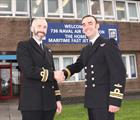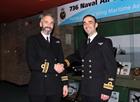NAVY HAWKS GET NEW BOSS
It’s all change at the top for Royal Naval Air Station Culdrose’s Fast Jet Hawk T1 Squadron.
Lieutenant Commander Barry Issitt (39) has assumed command of 736 Naval Air Squadron. The Fixed Wing Unit is the Fleet Air Arm’s Maritime Aggressor Squadron equipped with 14 Hawk T Mk1 twin seat aircraft.
He takes over from Lt Cdr Tim Flatman who had led 736 NAS since its re-commissioning in 2013, when it replaced the Fleet Requirements and Air Direction Unit (FRADU). During Tim’s time in the seat, the squadron has seen deployments toScotlandin support of Exercise Joint Warrior and further afield toAlbaniawhere they were flying as part of the Fleet’s Rapid Deployment Force. Tim moves onto a new appointment in the Fixed Wing Force at Culdrose.
Lt Cdr Barry Issitt was born in 1976 and raised on theSouthCoastuntil, at the age of 15, he emigrated toAustralia. Having lived and worked inAustraliafor 8 years he joined the Royal Navy in January 2000. Graduating fromBritanniaRoyalNavalCollegeatDartmouthin December 2000, he returned toAustraliato serve with the British Defence Liaison Service inCanberrabefore completing Basic Flying training. Selected for fixed wing training, Barry was awarded RN Pilot’s Wings in 2002, subsequently completing Advanced Flying Training and Tactical Weapons training on Hawk T1 atRAFValleyprior to a posting to 20(R) Squadron at RAF Wittering for operational conversion to the Harrier GR7 in 2005.
Upon completion, he moved to 1(F) Squadron at RAF Cottesmore flying Harrier GR7/9. Whilst serving on Joint Force Harrier he undertook a number of operational tours in Afghanistan on Op HERRICK, a personal highlight of which was aiding the location and destruction of the world’s largest narcotics cache (worth an estimated £225 million). Additionally he became qualified as a Harrier GR7/9 Electronic Warfare Instructor as well as completing embarked training and carrier qualification on HMS Illustrious.
Selected to become a Qualified Flying Instructor (QFI) he returned toRAFValleyand graduated with distinction from theCentralFlyingSchoolin 2009. Having taken up an instructional role at 208(R) Squadron teaching both RN and RAF pilots on the Hawk T1, he was subsequently assigned the position ofSeniorNavalOfficerRAFValley.
After the withdrawal of the Harrier from UK service in 2010, Lt Cdr Issitt undertook an exchange appointment with the French Navy, flying the venerable Super Etendard Modernisé with 17F at BAN Landivisiau (The French Fleet Air Arm Base in Brittany) becoming the first Royal Navy pilot to qualify on the type. Following this, he returned to theUKto join the Navy Headquarters Carrier Strike division as the Lightning II desk officer, responsible for aiding the integration of F-35B with the Queen Elizabeth class aircraft carriers, a role that culminated in becoming the inaugural recipient of the HMS Queen Elizabeth aviation sword.
“It’s a great honour to command 736 Naval Air Squadron,” said Lt Cdr Barry Issitt. “The next few years are going to be very busy for the Fixed Wing Force and Culdrose’s Hawks in particular. I look forward to the challenges ahead and flying from one of the Nation’s Key ‘Core Air Stations’.”




